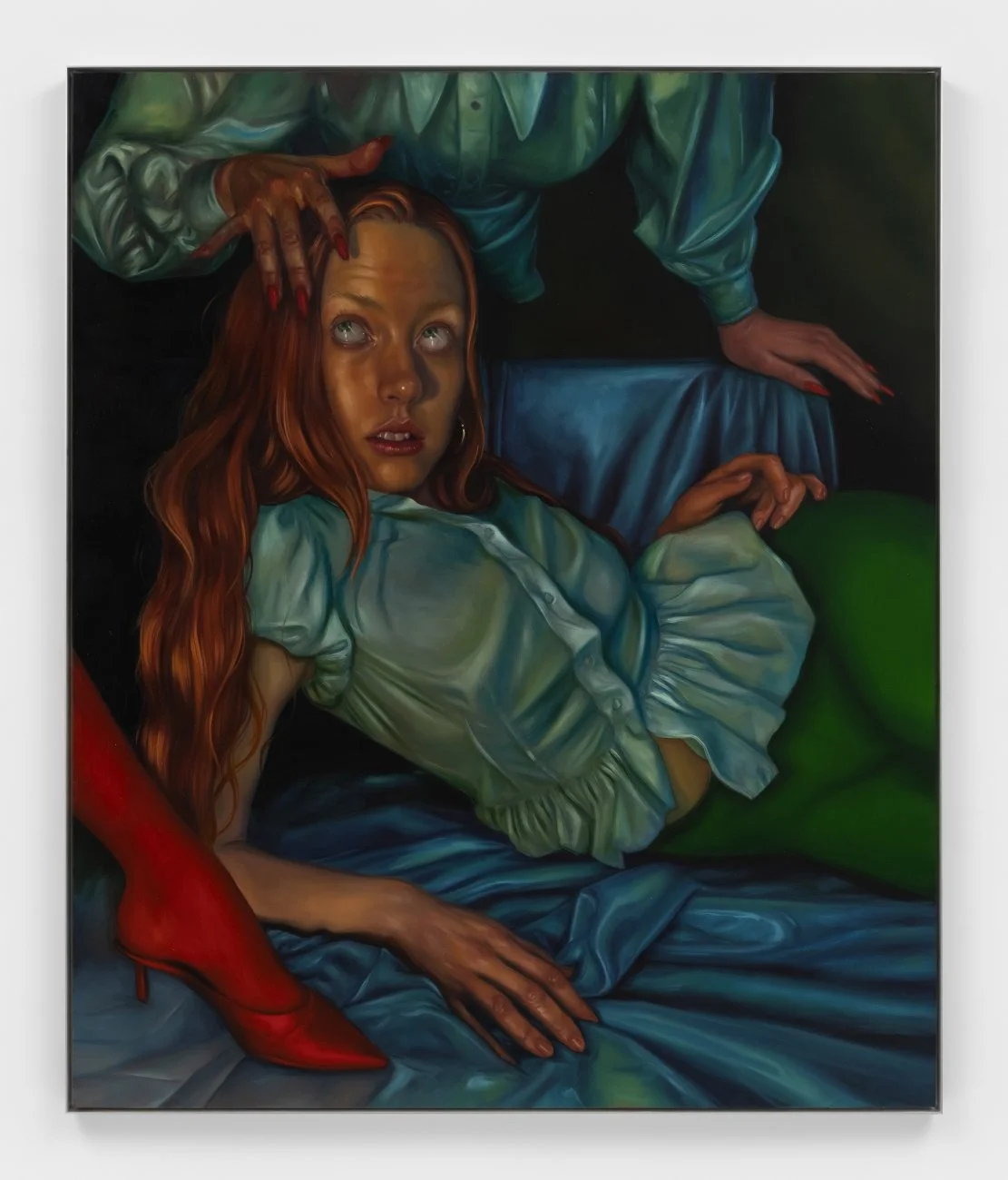Time to Pretend
Almost every work in Chloe Wise’s solo exhibition, Myth Information at Almine Rech, depicts an interior scene. The one or two works that could conceivably show the outdoors do so only in faint suggestions. In one example, a few grey smudges in the background of a closely cropped painting of a woman’s head loosely recall Anthony van Dyck clouds. For the most part, the paintings on view don’t reveal much about their surroundings—that doesn’t seem to be the point.
Wise’s painting primarily emphasizes the interplay of surfaces and textures clamoring for space in the foreground. The press release references sources in Italian Baroque and High Renaissance art, but while there’s no shortage of ornate detail and chiaroscuro lighting, these works fit with even more stylized veins of historical painting, such as Mannerism and Pre-Raphaelite art. Intentionally enlarged hands and elongated limbs are more Bronzino than Bellini.
Fabric, shoes, jewelry, hands, hair, and glossy faces form the main compositional elements of most works on view. In Visionary rumor (2025), a woman reclines in the center of the picture against blue drapery. A red stockinged foot emerges from the left side of the canvas, and from above the frame, the hands of an unseen female figure caress the head of the central figure. It seems relevant that the hand touching the girl’s head is substantially more modeled than the smoother and more vaguely rendered hand that rests on the drapery at upper right. Similarly, the crimson heel is deliberately less textured than the rumpled blue blouses. Tactile features such as smoothness and wrinkledness or texturedness are heightened and contrasted with each other in notable ways throughout the composition, while arms and legs often interject from offstage to frame and caress a central form. Wise elaborates the theme of tactility both in her treatment of texture and the depiction of touch.
There are effectively three modes of address from the people depicted in these paintings—three postures that deal with the idea of the beholder. In the first and most common mode, the figures, most of which are women, look upward within a scene, gazing at something or someone within the fictional world of the painting, but not depicted. In other instances, the sitters face and confront the beholder head on, Manet style. Lastly, a sitter might be depicted with their back to the picture plane, or with their face hidden, acknowledging the presence of a beholder by turning away from them. All three modes are thematized as the subject of Numinous communion (2025), where each of the figures embody one of the aforementioned relationships—intense captivation with something not depicted and therefore pointedly unavailable to the viewer, direct outward gaze that shatters the illusion of theatricality, or an outright refusal marked by turning away.
Relative shininess or glossiness is central in this work as well, like in the relationship between the vertical silver earring of the central figure, which makes an imaginary line with the painted nails and metallic drapery of the sitter to the right, whose forearm makes a parallel line with the scissors held by the woman on the left. This metallic glimmer is exaggerated and contrasted with what could be called fleshiness. Anatomy is almost always distorted; dark and light are thrown in high contrast, with black backgrounds and close, bright, light sources.
While the large paintings with multiple figures generate dynamic compositional effects through intertwined limbs and seek to balance a wider range of surface textures and colors, the smaller portraits achieve the same interest through simpler means. In Screen memories (2025), a red-tinted portrait elegantly triangulates a relationship between the glossy shine of the face, the smooth linear quality of the hair, and the much brushier, almost explosive, tinselled earring.
In a 2022 interview, Wise revealed that she sources reference images from photos of her friends in her camera roll. Although it’s unclear whether the works in Myth Information were also composed this way, it might explain how these images achieve a sense of compositeness and tactility. Instead of the naturalism of models drawn from life, it is as if several different images have been segmented into parts and melded into one scene. This sense of disjunction and artificiality generates much of the tension in the show. Everything is extra-whatever it would be—collars are extra pointy, faces are extra dewy. What is this exaggeration in service of, besides making an interesting picture? It’s tempting to read Wise’s attention to surfaces as a continuation of the engagement with consumerism she first addressed in the earlier food sculptures.
In Myth Information, dense scenes of tangible sensory experience echo the kinds of imagery used in advertising to provoke desire. They’re also not far from the covetous aspect of historical portraiture, where wealthy patrons flashed Ming ceramics and satin dresses to document their tasteful possessions. In Wise’s work, this striving has a tinge of irony—are we watching people dress up? Is that shirt silk or a polyester blend? Ultimately, these works act neither as expressions nor provocations of desire. Perhaps, more interestingly, the newest era of Wise’s painting depicts closeness from a vantage point of cool detachment.
Chloe Wise: Myth Information is on view at Almine Rech from September 18 through October 25, 2025.




